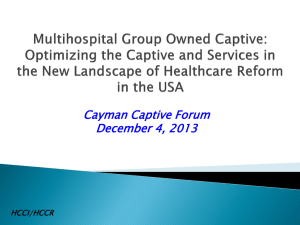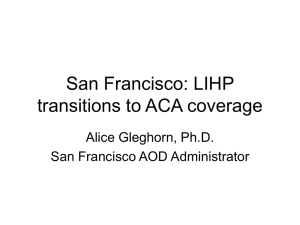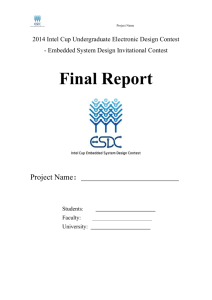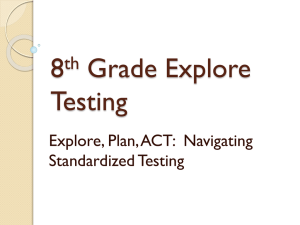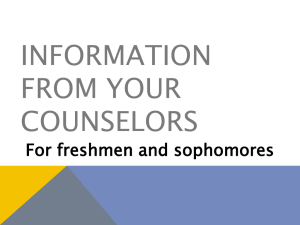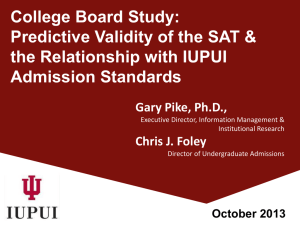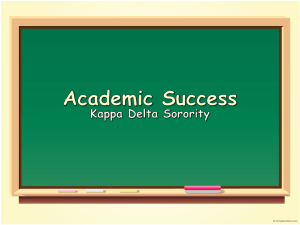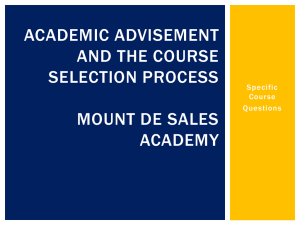Hope-Centered Career Development with College Students
advertisement
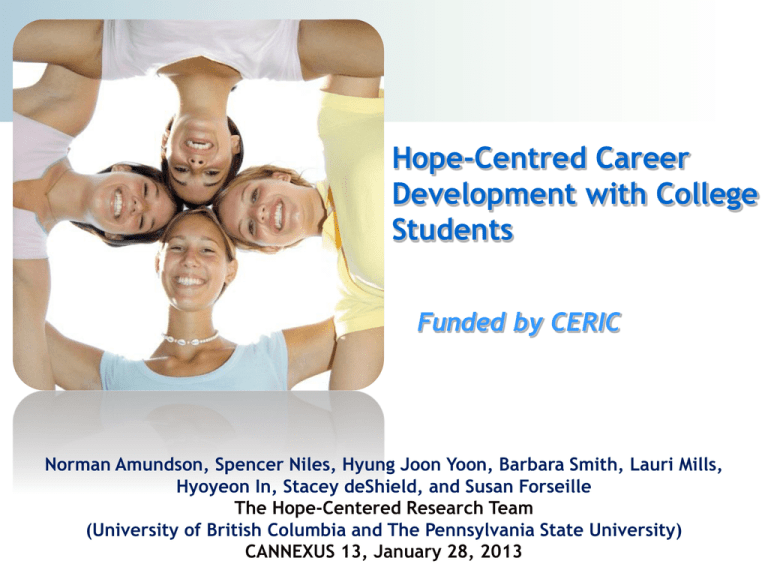
Hope-Centred Career Development with College Students Funded by CERIC Norman Amundson, Spencer Niles, Hyung Joon Yoon, Barbara Smith, Lauri Mills, Hyoyeon In, Stacey deShield, and Susan Forseille The Hope-Centered Research Team (University of British Columbia and The Pennsylvania State University) CANNEXUS 13, January 28, 2013 Hope-Centered Career Development Research Team Barbara Agenda • Introduction • Part 1. Quantitative Study • Part 2. Qualitative Study • Part 3. Application of the Hope-Centered Model of Career Development • Discussions / Summary Three Goals • What are 3 goals you hope to accomplish in the next 3 years? • Identify 3 action steps you will need to take to achieve each goal (3 steps per goal). • Rate yourself on a scale of 1-5 for each goal relative to whether you think you can and will take the actions you identified as necessary for achieving your goals. – 1= Not gonna happen – 5= It’s in the bag Three Theories Converge into the Hope-Centered Career Model Snyder’s Hope Theory •Goals •Pathways •Agency Hall’s Protean Career Theory •Self-identity (Self-clarity) •Adaptability Bandura’s Human Agency Theory •Self-reflectiveness (Self-reflection) •Forethought (Visioning) •Intentionality (Goal Setting) •Self-reactiveness (Implementing) Hope-Centered Career Development Model Hope-Centered Career Inventory (HCCI) Purpose •To assess clients’ hope-centered career competencies Target Population •8th graders or above Items •28 items and the following subscales: 1) hope 2) self-reflection 3) self-clarity 4) visioning 5) goal setting & planning 6) implementing 7) adapting Reliability and Validity •Internal consistency: Good (overall: .914, sub scales: .606 ~ .812) •Construct validity (CFA): Good (RMSEA: .065, CFI: .96, NNFI: .95) -Niles, Yoon, & Amundson, 2010 Part I. Quantitative Study Purpose 1.To establish the baseline of the Hope-Centered Career Inventory (HCCI) scores of students in Canada and the United States. 2.To understand the role of hope in the relationships with student engagement, academic achievement, and vocational identity. Conceptual Model GPA Hope Student Engagement Vocational Identity Methods • Sample: 1685 undergraduate students in Canada and the U.S. • Data Collection: A web-based survey was conducted • Measures: • • • • Hope-Centered Career Inventory (HCCI; Niles et al., 2010) Vocational Identity Scale (Holland et al., 1980) Student Engagement Questionnaire (Kuh, 2001) Self-Reported GPA • Data Analysis: Descriptive analyses, T-tests, Structural Equation Modeling (SEM) Demographics Gender (%) Race (%) School Total (n) Female Male White Year in School (%) Visible 1st, 2nd year Minorities Above 2nd year UBC(CA) 447 74.3 25.7 34.9 65.1 41.2 58.8 TRU(CA) 229 71.2 28.8 84.7 15.3 70.3 29.7 PSU(US) 643 64.1 35.9 79.8 20.2 94.6 5.4 PCT(US) 366 50.8 49.2 94.3 5.7 56.6 43.4 Total 1685 64.9 35.1 71.7 28.3 68.8 31.2 Results: Baseline Scores of the HCCI Comparison between Canada and the US Canada (n = 676) US (n = 1009) t M SD M SD HCCI (Overall) 3.23 .38 3.40 .36 -9.12 Hope 3.25 .59 3.50 .49 -8.95 Self-reflection 3.27 .46 3.35 .44 -3.39 Self-clarity 3.19 .55 3.43 .48 -9.18 Visioning 3.34 .55 3.52 .50 -6.66 Goal setting and planning 3.08 .59 3.19 .59 -3.76 Implementing 3.10 .53 3.32 .51 -8.58 Adapting 3.39 .45 3.50 .44 -4.78 Results: Baseline Scores of the HCCI Canada (University of British Columbia, Thompson Rivers University) visioning goal setting/ planning Implementing adapting overall 2.50 2.50 2.25 2.43 2.75 2.75 3.00 2.75 3.00 2.75 2.75 3.00 2.96 3.25 3.25 3.25 3.50 3.00 3.00 3.50 3.25 75 3.75 3.50 3.50 3.75 3.50 3.50 3.75 3.50 90 4.00 3.75 4.00 4.00 3.75 3.75 4.00 3.75 hope selfreflection selfclarity 10 2.50 2.75 25 3.00 50 Percentiles Results: Baseline Scores of the HCCI United States (Penn State University, Penn College) visioning goal setting/ planning Implementing adapting overall 2.75 2.75 2.25 2.50 3.00 2.89 3.00 3.00 3.25 2.75 3.00 3.25 3.18 3.50 3.50 3.50 3.75 3.25 3.25 3.50 3.43 75 4.00 3.75 3.75 4.00 3.75 3.75 4.00 3.68 90 4.00 4.00 4.00 4.00 4.00 4.00 4.00 3.86 hope selfreflection selfclarity 10 3.00 2.75 25 3.25 50 Percentiles Results: The Role of Hope After controlling for country, age, race, and parental educational level… Data: ALL (Canada + US) GPA .031 Hope .377* .127* HopeGPA .078* Student Engagement .100* .370* DF = 67 Chi-Square = 241.252* RMSEA = .055 NNFI = .960 CFI = .974 Vocational Identity HopeVI .407* Conclusions Above and beyond the effects of demographic variables (country, age, race, and parental education), • Hope directly and indirectly (via school engagement) affects vocational identity (large b-weight, .407) • Hope indirectly (via school engagement) affects GPA • The effect of hope on GPA is minimal, although significant • School engagement mediates the effect of hope on vocational identity (partially) and GPA (fully) Limitations & Suggestions • Limitations – – – – Cross sectional data Non-random convenience sampling Limited to four institutions in the US and Canada Self-reported measure • Suggestions – – – – Longitudinal study More rigorous sampling procedure More participation from across the nations Use of objective approaches (observation, institutional data, etc.) Part II. Qualitative Study Purpose 1.To understand how college and university students in Canada and the U.S., in the face of challenges, experience high levels of hope. Specifically, what helps and hinders their experiences of hope? Inclusion Criteria • Highest level of Hope on HCCI: 4.0 • Highest levels of self reported perceived barriers (McWhirter, 1992) of the highest level of Hope group: 2.81 – 3.71 • Sample items of the perceived barriers scale – Money problems are ... – Family problems are ... – Not being smart enough is ... – Not being prepared enough is... – My gender is... – Relationship concerns are ... “currently a barrier to my educational aspirations” Note. 1=strongly agree 5=strongly disagree The total score may under represent the level of barriers Inclusion Criteria • Fluent in English • 19 of 676 (2.8%) in Canada met inclusion criteria – 7 participated (36.8%) • 27 of 1009 (2.6%) in U.S. met inclusion criteria – 8 participated (29.6%) Note: Extremely high rate of participation relative to sample size Critical Incident Technique • Helpful and hindering factors • Incidents include antecedent information, detailed description of experiences, descriptions of the outcomes. Data Collection Informed consent Primary Interview 45 – 90 minutes In-depth, semi-structured & open-ended with clarifying questions 15 interviews, by 5 telephone & 10 inperson Audio recorded with handwritten notes Follow-up contact via email and by phone for data validation Analysis & Rigour Audiotaping & transcription Experts to review transcripts Exhaustiveness Independent extraction Independent category formation Checking with participants Focusing on primary categories Determination of practical use of categories by an expert • Comparison with literature • • • • • • • • Participant Demographics • 5 UBC, 2 TRU, 1 Penn College, 7 Penn State • 13 Female, 2 Male • 7 U.S. / 7 Canadian / 1 international student • Age range: 18-25 • Average age: 20.5 • 1 Married, 14 Single • 8 Caucasian, 3 Asian, 2 African American, 1 Asian & Caucasian, 1 Middle Eastern • 14 English as a first language; 1 Mandarin as first language • All undergraduates in 1st & 2nd year • Diverse majors Barriers • physical and mental health, undiagnosed learning disabilities, sexual, physical, emotional and economic abuse, sexual harassment, financial, parents divorce, neglect, death of loved ones, intergenerational conflict, body image, expectations Preliminary Helping Factors Number of Incidents 44 Number of Participants 14 % of Total Participants 100 2. Future Goals 19 10 100 3. Role Models 27 9 71% 4. Attitude 24 7 64% 5. Career & Academic Passion 13 7 50% 6. Possibilities & Opportunities 14 5 50% 7. School Experience 10 5 36% 8. Social & Professional Contribution 11 5 36% 8. Self-efficacy 5 4 36% 9. Spirituality 5 4 26% 10. Refocusing activities* 4* 4* 26% Categories 1. Support Support • family, partners, friends, organization, Gus the Cat financial, emotional social media, networking • ”[mom’s] just been that strong person for me. And I can call her … any time. She is really just that voice of reasoning and hope for me." Future Goals • educational including getting degree or going to grad school, starting careers, starting a family, being independent • "knowing I'm going to school and there will be a change and I can see my life hitting a major goal, that's what is inspiring and hopeful to me …" Role Models • People in participants' personal lives such as family or friends, professionals such as counsellors, or public figures who inspired the participants • "seeing how positively [working with her] affected my own thoughts and person in life, it really made me want to have that influence on someone else. I really wanted to ... be able to say, "hey, I helped that one person and I changed their life in some way …" Attitude • Beliefs or perspectives which sometimes included selftalk • "it could be worse” • 7 participates endorsed “attitude” but they all exhibited it Preliminary Hindering Factors Number of Incidents Number of Participants % of Total Participants 1. Negative & Unsupportive People 17 12 86% 2. Negative Feelings & Thoughts 20 8 57% 3. Situations Outside of One’s Control 13 6 43% 4. Economic and Financial Challenges 10 5 36% 5. School 10 5 36% 6. Physical & Mental Health* 5 4 26% Categories Situations Outside of One’s Control • Negative and or unexpected situations that they could not control and produced feelings of uncertainty • Examples included: unexpected eviction, parents’ divorce, being bullied, negative consequences at Penn State, the environment, social and political concerns including religious freedom and corruption, • "I'm a really planned, meticulous person, … I usually have my life planned out three months in advance, so the entire idea of the uncertainty of the future definitely did add in to the removal of hope" Part III. Application of the Hope-Centered Model of Career Development • Use of HCCI as a preliminary career assessment tool • Exploring the applicability of the model and the use of the HCCI with a university population. • Future studies looking at other groups (unemployed, multi-barriered, aboriginal, cross-cultural) Case of Emily • • • • • • • • • • An incoming senior year student in Psychology at a large public university. She is the oldest of two children and a first generation college student. She has a 3.79 cumulative GPA and has received positive feedback from professors. She enjoys interacting with people and tries to help out wherever she can. She volunteered as a camp counsellor for elementary school students over the past two summer vacations with her close friends (rewarding experience for her.). Other than this, she does not have any work/internship experience. She has thought about becoming a professor because of its flexibility and contribution to the development of students. She is considering studying at a master's program but could not decide a major yet Her options include clinical psychology, developmental psychology, industrial and organizational psychology, school counselling, and human development. Financially, her parents won’t be able to support her graduate education. It is difficult for her to narrow down her future possibilities and take action toward a specific goal. Emily’s HCCI Result Hope Adapting Self-Reflection Implementing Goal Setting & Planning Self-Clarity Visioning Your Emily’s Score Group 25% Group 75% Discussion Questions for Emily’s Case • What are Emily’s main career concerns? • Look at his HCCI results. What are her strengths? What are some of her challenges? • As her career counselor, what would be some potential interventions regarding her career concerns? Contact Information • Dr. Norman Amundson • Dr. Spencer Niles • Dr. Hyung Joon Yoon • Barbara Smith • Lauri Mills • Hyoyeon In • Stacey deShield • Susan Forseille norman.amundson@ubc.ca sgn3@psu.edu hj.yoon@aui.ma bsmith18@shaw.ca laurimills@gmail.com hoi5006@psu.edu sid108@psu.edu sforseille@tru.ca A Web-based system for HCCI • Web-based HCCI: the only available format at this moment • Both practitioners and researchers can request the use of the web-based HCCI by contacting Dr. Hyung Joon Yoon (drmtree@gmail.com) • Individuals who have a pass code can take the HCCI and download an automated report in a PDF format . . . . . . Thank You!
